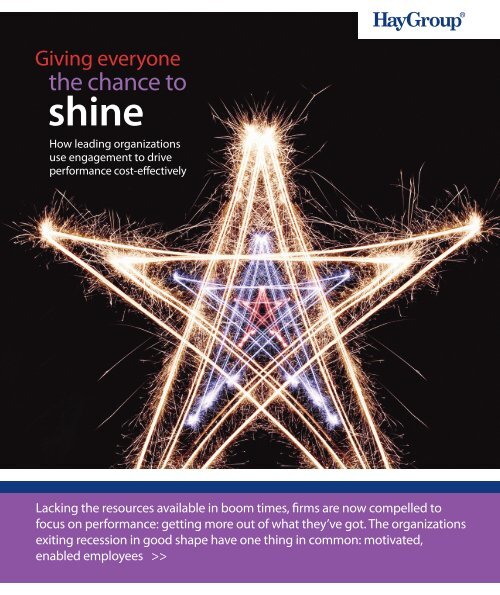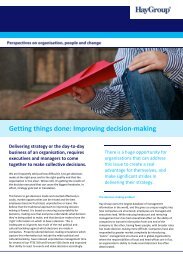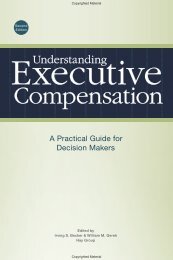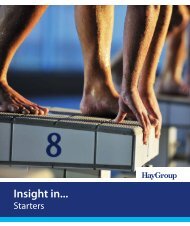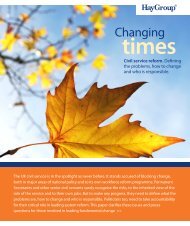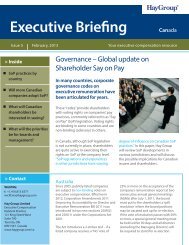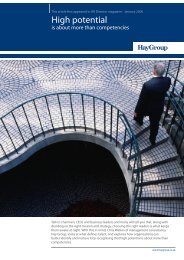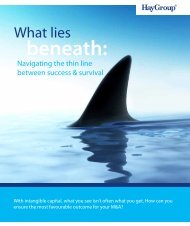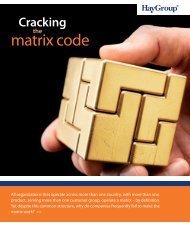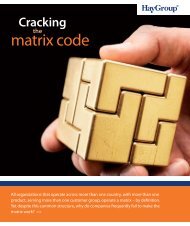Giving everyone the chance to shine | whitepaper | PDF - Hay Group
Giving everyone the chance to shine | whitepaper | PDF - Hay Group
Giving everyone the chance to shine | whitepaper | PDF - Hay Group
Create successful ePaper yourself
Turn your PDF publications into a flip-book with our unique Google optimized e-Paper software.
<strong>Giving</strong> <strong>everyone</strong><br />
<strong>the</strong> <strong>chance</strong> <strong>to</strong><br />
<strong>shine</strong><br />
How leading organizations<br />
use engagement <strong>to</strong> drive<br />
performance cost-effectively<br />
Lacking <strong>the</strong> resources available in boom times, firms are now compelled <strong>to</strong><br />
focus on performance: getting more out of what <strong>the</strong>y’ve got. The organizations<br />
exiting recession in good shape have one thing in common: motivated,<br />
enabled employees >>
“<br />
The world’s leading<br />
organizations know that<br />
performance comes from<br />
people – but only when<br />
people feel motivated<br />
and enabled <strong>to</strong> perform.<br />
”
Contents<br />
Executive summary<br />
2<br />
Part 1: Post-recession, performance is <strong>the</strong> focus<br />
4<br />
The benefits of engagement<br />
5<br />
Engagement is not enough<br />
6<br />
Part 2: How <strong>to</strong> achieve <strong>the</strong> performance dividend from engagement<br />
8<br />
Conclusion<br />
12
2<br />
<strong>Giving</strong> <strong>everyone</strong> <strong>the</strong> <strong>chance</strong> <strong>to</strong> <strong>shine</strong><br />
Executive summary<br />
The post-downturn landscape is <strong>to</strong>ugh. Recession-battered<br />
firms must fight off fast-growing global competi<strong>to</strong>rs while<br />
heeding cus<strong>to</strong>mer demands for better service – and employees’<br />
cries for more fulfilling jobs.<br />
Lacking <strong>the</strong> resources and funding that were available in<br />
<strong>the</strong> boom times, organizations are now compelled <strong>to</strong> focus<br />
on performance: getting more out of what <strong>the</strong>y’ve got.<br />
This means <strong>the</strong>y need <strong>to</strong> be agile and<br />
flexible, especially <strong>to</strong> cope with <strong>the</strong> rapid<br />
changes that characterize <strong>the</strong> new business<br />
environment. As well as focusing on <strong>the</strong><br />
hunt for new business, <strong>the</strong>y need <strong>to</strong> ‘take<br />
care of business’, nurturing <strong>the</strong> cus<strong>to</strong>mer<br />
relationships that sustain <strong>the</strong>m.<br />
Our recent studies show that <strong>the</strong> firms<br />
achieving all this share one thing in common:<br />
motivated, empowered employees.<br />
The link between employee engagement<br />
and performance is well proven. With people<br />
prepared <strong>to</strong> ‘go <strong>the</strong> extra mile’, our studies<br />
show firms can achieve revenue growth 2.5<br />
times that of peers and cut staff turnover<br />
by up <strong>to</strong> 40 per cent. However engagement<br />
alone is not enough. <strong>Hay</strong> <strong>Group</strong>’s research<br />
shows that while nine out of ten employees<br />
say <strong>the</strong>y are committed <strong>to</strong> success, less than<br />
two thirds believe <strong>the</strong>y are as productive as<br />
<strong>the</strong>y could be. That’s a lot of wasted eagerness.<br />
The missing piece is ‘enablement’ –<br />
summed up with <strong>the</strong> cry “help me help you.”<br />
<strong>Hay</strong> <strong>Group</strong>’s work shows that when<br />
people are both engaged and enabled,<br />
<strong>the</strong> performance dividend increases<br />
dramatically. Here’s how <strong>to</strong>p<br />
organizations realize it.<br />
©2010 <strong>Hay</strong> <strong>Group</strong>. All rights reserved
• Know who you are, build your employer brand – Our Best Companies for<br />
Leadership survey showed that <strong>the</strong> <strong>to</strong>p-scoring firms all shared a clarity of mission<br />
and identity. Nearly 90 per cent of <strong>the</strong>m have developed an explicit employer brand<br />
compared <strong>to</strong> only two-thirds of peers. They are also on <strong>to</strong>p of important workplace<br />
trends. They have more women in senior posts and use corporate social<br />
responsibility (CSR) credentials <strong>to</strong> attract staff.<br />
• Spend wisely – In our The Changing Face of Reward study, we saw a strong trend<br />
<strong>to</strong> link performance more tightly <strong>to</strong> reward. However firms in <strong>the</strong> World’s Most<br />
Admired Companies list resist <strong>the</strong> temptation just <strong>to</strong> set financial-related measures,<br />
focusing instead on metrics that work for <strong>the</strong> long-term: teamwork, cus<strong>to</strong>mer<br />
loyalty, building human capital. Overall, firms are using reward <strong>to</strong> shift from a<br />
culture of entitlement <strong>to</strong> one of performance. And <strong>the</strong>y are making sure that<br />
<strong>everyone</strong> – not just ‘stars’ – has a <strong>chance</strong> <strong>to</strong> get <strong>the</strong>ir efforts recognized.<br />
• Inspire your people – Our work constantly reinforces <strong>the</strong> importance<br />
of leaders in driving performance. Yet a recent <strong>Hay</strong> <strong>Group</strong> study suggests only<br />
26 per cent of leaders create high-performance climates. The Best Companies for<br />
Leadership take this issue seriously. Nearly all of <strong>the</strong>m empower <strong>the</strong>ir employees<br />
<strong>to</strong> behave like leaders, compared with only two-thirds of peers. And <strong>the</strong>y set s<strong>to</strong>re<br />
by leadership qualities like inspiration and teamwork. The result is a culture that<br />
enables employees <strong>to</strong> perform.<br />
In summary<br />
The world’s leading organizations are responding <strong>to</strong> <strong>the</strong> global squeeze by eking every<br />
last drop of performance out of <strong>the</strong>ir people and structures. Yet <strong>the</strong>y are not doing this<br />
by cuts or coercion. Recognizing that enthusiastic, enabled people are <strong>the</strong> key <strong>to</strong><br />
performance, <strong>the</strong>y cultivate ‘employer brands’ that staff are proud of, craft reward programs<br />
that drive <strong>the</strong> right behaviors, and develop leaders who create inspiring climates.<br />
“<br />
Lacking <strong>the</strong> resources and<br />
funding that were available in<br />
<strong>the</strong> boom times, organizations<br />
are now compelled <strong>to</strong> focus<br />
on performance.<br />
”
4<br />
<strong>Giving</strong> <strong>everyone</strong> <strong>the</strong> <strong>chance</strong> <strong>to</strong> <strong>shine</strong><br />
Part 1: Post-recession, performance is <strong>the</strong> focus<br />
As <strong>the</strong> dust of <strong>the</strong> downturn settles, organizations will be<br />
looking <strong>to</strong> position <strong>the</strong>mselves in <strong>the</strong> new business landscape.<br />
One that’s <strong>to</strong>ugher and more competitive than before.<br />
Globalization now means threat as well as<br />
opportunity. Many recession-battered<br />
Western companies find <strong>the</strong>mselves operating<br />
in increasingly mature markets; <strong>the</strong>y face<br />
growing competition from what were once<br />
emerging markets. All are looking ahead,<br />
focusing on growth markets and at <strong>the</strong> same<br />
time maintaining <strong>the</strong> pressure on costs.<br />
Yet, against this backdrop, cus<strong>to</strong>mers haven’t<br />
s<strong>to</strong>pped demanding ever greater levels of<br />
service. And despite <strong>to</strong>ugh times, employees<br />
are expecting more from <strong>the</strong>ir work –<br />
seeking personal fulfillment, not just a job.<br />
Organizations must respond <strong>to</strong> <strong>the</strong>se<br />
pressures in order <strong>to</strong> survive. But without<br />
<strong>the</strong> finance and resources that were available<br />
before <strong>the</strong> downturn, <strong>the</strong>y are left with one<br />
option: focusing on performance or, <strong>to</strong> put<br />
it ano<strong>the</strong>r way, getting more out of <strong>the</strong>ir<br />
existing capability.<br />
It means gearing <strong>the</strong> firm up <strong>to</strong> respond<br />
quickly <strong>to</strong> <strong>the</strong> accelerating pace of change<br />
in many industry sec<strong>to</strong>rs. But it also forces<br />
attention on one of <strong>the</strong> basics of business:<br />
looking after existing cus<strong>to</strong>mer relationships<br />
(which are, after all, <strong>the</strong> bedrock of most<br />
organizations) as well as pursuing<br />
new cus<strong>to</strong>mers.<br />
Recent <strong>Hay</strong> <strong>Group</strong> studies suggest<br />
that firms performing well in this new,<br />
lean environment have one thing in common:<br />
motivated, enabled employees focused on<br />
clear business-relevant goals. It’s this fac<strong>to</strong>r<br />
that gives <strong>the</strong>m <strong>the</strong> agility <strong>the</strong>y need. Yet how<br />
do <strong>the</strong>y achieve this when resources are tight?<br />
“<br />
Yet, against this backdrop,<br />
cus<strong>to</strong>mers haven’t s<strong>to</strong>pped<br />
demanding ever-greater<br />
levels of service.<br />
”<br />
©2010 <strong>Hay</strong> <strong>Group</strong>. All rights reserved
The benefits of engagement<br />
The link between engagement and performance is well<br />
proven. The more enthusiastic and motivated your people are,<br />
<strong>the</strong> more <strong>the</strong>y will contribute. What’s interesting about our<br />
recent studies is <strong>the</strong> way in which <strong>the</strong>y show high-performing<br />
organizations have used and fostered engagement even<br />
when recession would be expected <strong>to</strong> drive levels down.<br />
Highly engaged employees<br />
are <strong>the</strong> people who are<br />
committed and will ‘go <strong>the</strong><br />
extra mile’ for your firm.<br />
They are very valuable and<br />
have <strong>the</strong> potential <strong>to</strong> be<br />
extremely productive. With<br />
high levels of engagement,<br />
firms can see revenue<br />
growth 2.5 times that<br />
of <strong>the</strong>ir peers and a 40<br />
per cent reduction in<br />
expensive staff turnover.<br />
Source: linkage case studies using<br />
<strong>Hay</strong> <strong>Group</strong>’s normative database<br />
Our research in<strong>to</strong> this year’s FORTUNE<br />
World’s Most Admired Companies<br />
(WMACs) shows that <strong>the</strong>y are emerging<br />
from recession in better shape than before,<br />
with more committed and motivated<br />
employees. Nearly 70 per cent of WMACs<br />
report greater levels of engagement<br />
post-downturn compared <strong>to</strong> just under<br />
50 per cent of <strong>the</strong>ir peer group. They have<br />
only had <strong>to</strong> commit <strong>to</strong> half <strong>the</strong> levels of<br />
layoffs and hiring or compensation freezes<br />
that <strong>the</strong>ir peers have had <strong>to</strong> initiate.<br />
The benefits of this are clear. Nearly all<br />
of <strong>the</strong> WMACs report that <strong>the</strong>ir engagement<br />
efforts reduce staff turnover, compared <strong>to</strong><br />
two-thirds of <strong>the</strong>ir peers. The ROI of this is<br />
immediately apparent, given that <strong>the</strong> cost<br />
of replacing an employee can be between 50<br />
and 150 per cent of salary. The WMACs also<br />
credit <strong>the</strong>ir engagement efforts with creating<br />
competitive advantage, streng<strong>the</strong>ning<br />
cus<strong>to</strong>mer relationships and reducing<br />
employee performance issues. In each case,<br />
<strong>the</strong>y’ve achieved more through engagement<br />
than <strong>the</strong>ir peers.<br />
In <strong>the</strong> Best Companies for Leadership survey,<br />
conducted in partnership with Bloomberg<br />
BusinessWeek online, we examined how<br />
organizations were preparing for <strong>the</strong> new<br />
business reality from <strong>the</strong> perspective of<br />
leadership. It was clear from our study that<br />
investment in leadership pays off, with <strong>the</strong><br />
<strong>to</strong>p 20 Best Companies showing significantly<br />
better shareholder return than <strong>the</strong> S&P 500.<br />
This investment has driven productive<br />
levels of engagement <strong>to</strong>o. Of <strong>the</strong> best<br />
companies, 90 per cent give <strong>the</strong>ir employees<br />
<strong>the</strong> opportunity <strong>to</strong> behave like leaders,<br />
compared <strong>to</strong> only two-thirds of <strong>the</strong>ir peers.<br />
Handed this responsibility, employees<br />
are motivated <strong>to</strong> perform.<br />
“<br />
Recent <strong>Hay</strong> <strong>Group</strong> studies suggest that firms<br />
performing well in this new, lean environment have one<br />
thing in common: motivated, enabled employees.<br />
”
6<br />
<strong>Giving</strong> <strong>everyone</strong> <strong>the</strong> <strong>chance</strong> <strong>to</strong> <strong>shine</strong><br />
Engagement is not enough<br />
There’s a problem with engagement, though. Many organizations<br />
with highly motivated workforces still struggle with performance<br />
issues. <strong>Hay</strong> <strong>Group</strong>’s normative database shows that while nine<br />
out of ten employees say <strong>the</strong>y are committed <strong>to</strong> success, less than<br />
two thirds believe <strong>the</strong>y are as productive as <strong>the</strong>y could be.<br />
That’s a lot of wasted eagerness. The missing<br />
piece is ‘enablement’: best summed up with<br />
<strong>the</strong> cry “help me help you.” Employees need<br />
<strong>to</strong> be able <strong>to</strong> channel <strong>the</strong>ir enthusiasm in<strong>to</strong><br />
productive and satisfying action: put in<strong>to</strong><br />
roles that leverage <strong>the</strong>ir skills, and given<br />
<strong>the</strong> <strong>to</strong>ols and <strong>the</strong> freedom <strong>to</strong> be effective.<br />
Without this, <strong>the</strong>y may lose motivation,<br />
dial down <strong>the</strong>ir efforts or even leave.<br />
<strong>Hay</strong> <strong>Group</strong>’s work shows that when<br />
people are both engaged and enabled,<br />
<strong>the</strong> performance dividend<br />
increases dramatically.<br />
“<br />
While nine out of ten employees say <strong>the</strong>y<br />
are committed <strong>to</strong> success, less than two<br />
thirds believe <strong>the</strong>y are as productive as<br />
<strong>the</strong>y could be.<br />
”<br />
©2010 <strong>Hay</strong> <strong>Group</strong>. All rights reserved
The business case for engaging and enabling employees<br />
High engagement<br />
only<br />
High engagement +<br />
high enablement<br />
Employee performance<br />
Increase in employees<br />
above performance<br />
expectiations<br />
10%<br />
50%<br />
Employee retention<br />
Reduction in<br />
turnover rates<br />
-40%<br />
-54%<br />
Cus<strong>to</strong>mer satisfaction<br />
Cus<strong>to</strong>mer satisfaction<br />
rates<br />
71%<br />
89%<br />
Financial success<br />
Revenue growth<br />
x2.5<br />
x4.5<br />
Based on linkage case studies using <strong>Hay</strong> <strong>Group</strong>’s global normative database
8<br />
<strong>Giving</strong> <strong>everyone</strong> <strong>the</strong> <strong>chance</strong> <strong>to</strong> <strong>shine</strong><br />
Part 2: How <strong>to</strong> achieve <strong>the</strong> performance<br />
dividend from engagement<br />
Today’s climate, however, seems hardly conducive <strong>to</strong> engaging<br />
people. Budgets are tight and <strong>the</strong> best people have most likely<br />
been shouldering <strong>the</strong> burden – often doing more than one job<br />
– for some time. How do you s<strong>to</strong>p <strong>the</strong>se people from walking<br />
as <strong>the</strong> markets recover? The <strong>to</strong>p-performing companies have<br />
worked out a formula for keeping people engaged. It’s about<br />
taking a step back and deciding what you can offer employees<br />
beyond cash.<br />
Know who you are – build your employer brand<br />
One of <strong>the</strong> stand-out results from our Best Companies for Leadership survey was that<br />
<strong>the</strong> <strong>to</strong>p-scoring firms all shared a clarity of mission and identity. Southwest Airlines,<br />
for example, has not changed its mission statement in 22 years and even has a committee<br />
whose job it is <strong>to</strong> ensure that <strong>the</strong> company culture stays on track. This consistent ‘employer<br />
brand’ is a powerful force for inspiring loyalty and engagement – and attracting<br />
high performers.<br />
The World’s Most Admired Companies understand employer brand, <strong>to</strong>o. Nearly 90<br />
per cent of <strong>the</strong>m have developed an explicit employer brand compared <strong>to</strong> only<br />
two-thirds of peers.<br />
The <strong>to</strong>p 20 firms in <strong>the</strong> leadership study also did much better than <strong>the</strong>ir peers in<br />
addressing current trends that affect employees’ choices <strong>to</strong>day: accelerating globalization,<br />
work/life balance, <strong>the</strong> role of women in <strong>the</strong> workplace, a growing focus on <strong>the</strong> environment.<br />
Best Companies for Leadership score almost twice as high as peers in having a high<br />
proportion of women in senior leadership and in working from home. Over 90 per cent<br />
of <strong>the</strong>m want <strong>the</strong>ir employees <strong>to</strong> appreciate global issues, compared <strong>to</strong> fewer than 60 per<br />
cent of peers. And nearly all of <strong>the</strong> Best Companies are using <strong>the</strong>ir CSR credentials <strong>to</strong><br />
attract new staff, something that less than two-thirds of <strong>the</strong> ‘rest’ are doing.<br />
©2010 <strong>Hay</strong> <strong>Group</strong>. All rights reserved
How far could I go in this firm? Clearly seeing<br />
how <strong>the</strong>ir career could develop is key <strong>to</strong> attracting<br />
<strong>the</strong> best people and keeping <strong>the</strong>m motivated.<br />
Eighty per cent of <strong>the</strong> <strong>to</strong>p companies in our<br />
Best Companies for Leadership study report that<br />
“people stay at this company primarily for<br />
growth opportunities” compared with only 61<br />
per cent of peers. Over 80 per cent of <strong>the</strong>se firms<br />
also report that <strong>the</strong>y invest a lot in <strong>the</strong> people<br />
<strong>the</strong>y need.<br />
‘<strong>to</strong>tal reward’: creating and presenting a package<br />
that includes not just <strong>the</strong> fixed and variable financial<br />
elements but also intangible rewards such as career<br />
development, motivational leadership and<br />
challenging work.<br />
Knowing who you are – and presenting an offer<br />
<strong>to</strong> employees that goes beyond just a title and a<br />
salary <strong>to</strong> encapsulate this ‘employer brand’ – is key<br />
<strong>to</strong> effective engagement when resources are tight.<br />
The importance of career development is fur<strong>the</strong>r<br />
backed up by our recent Changing Face of Reward<br />
study, which highlights <strong>the</strong> latest reward practices.<br />
A key trend at successful companies is a shift <strong>to</strong><br />
“<br />
A consistent ‘employer brand’<br />
is a powerful force for inspiring<br />
loyalty and engagement – and<br />
attracting high performers.<br />
”
10 <strong>Giving</strong> <strong>everyone</strong> <strong>the</strong> <strong>chance</strong> <strong>to</strong> <strong>shine</strong><br />
Firms are using reward<br />
<strong>to</strong> make <strong>the</strong> shift from a<br />
culture of entitlement.<br />
Spend wisely<br />
The resources that organizations do<br />
have are being deployed very carefully.<br />
Even firms that are growing are taking<br />
an opportunity <strong>to</strong> reassess <strong>the</strong>ir cost base,<br />
optimize <strong>the</strong>ir management processes<br />
and put <strong>the</strong>ir operations on a more<br />
sustainable course for <strong>the</strong> future.<br />
Engagement is essential, as we’ve seen<br />
– but it must be achieved affordably.<br />
One way <strong>to</strong> do this is through careful<br />
tuning of reward programs. They must be<br />
motivating and linked tightly <strong>to</strong> business<br />
objectives. This was <strong>the</strong> message that came<br />
through in The Changing Face of Reward.<br />
Top six pay-for-performance actions<br />
1 Introduce differentiated reward<br />
structures where available rewards<br />
increasingly go <strong>to</strong> <strong>the</strong> <strong>to</strong>p performers<br />
and high potentials – those critical <strong>to</strong><br />
<strong>the</strong> survival of <strong>the</strong> business.<br />
2 Building management skills in setting<br />
goals, coaching and recognizing and<br />
rewarding performance.<br />
3 Clarify definitions of performance.<br />
4 Balance individual and enterprise<br />
targets for bonuses.<br />
5 Align individual targets <strong>to</strong> overall strategy.<br />
6 Make greater use of multiple rewards,<br />
mixing short-and long-term incentives<br />
with <strong>the</strong> motivational stimulus of better<br />
career development and varied and<br />
interesting work.<br />
We found that organizations in all sec<strong>to</strong>rs<br />
were working hard <strong>to</strong> link performance more<br />
tightly <strong>to</strong> reward. They talk of a shift from<br />
‘entitlement’, ‘paternalism’ and ‘comfort’ <strong>to</strong><br />
one of ‘performance’. In practice, this means<br />
differentiating reward according <strong>to</strong> each<br />
individual’s performance.<br />
“<br />
A ‘one size fits all’ reward program<br />
will not be applicable. The trend<br />
will go <strong>to</strong> ‘one size fits me’.<br />
Essent | Ne<strong>the</strong>rlands<br />
”<br />
The result is that <strong>the</strong> best performers have<br />
<strong>the</strong> highest earning power – indeed senior<br />
managers at <strong>the</strong> world’s <strong>to</strong>p firms earn 20<br />
per cent more than peers when bonuses<br />
are taken in<strong>to</strong> account.<br />
However organizations must resist <strong>the</strong><br />
temptation <strong>to</strong> set financial-related<br />
performance metrics. Why? Because it’s at<br />
odds with what The World’s Most Admired<br />
Companies do. Unlike <strong>the</strong>ir peers, <strong>the</strong>se<br />
companies’ reward metrics include measures<br />
around long-term thinking, teamwork,<br />
building human capital and cus<strong>to</strong>mer loyalty.<br />
It’s <strong>the</strong>se types of metrics that will drive<br />
long-term, sustainable performance and<br />
avoid encouraging <strong>the</strong> risky, short term<br />
behaviors that have caused so much trouble<br />
in <strong>the</strong> financial sec<strong>to</strong>r. In short, driving <strong>the</strong><br />
‘right’ performance is what matters.<br />
Our study showed that firms are<br />
differentiating reward for high performers<br />
so that <strong>everyone</strong> – not just <strong>the</strong> ‘stars’ – has<br />
<strong>the</strong> <strong>chance</strong> <strong>to</strong> have <strong>the</strong>ir efforts recognized.<br />
This, of course, is a key way <strong>to</strong><br />
engage employees.<br />
©2010 <strong>Hay</strong> <strong>Group</strong>. All rights reserved
Inspire your people<br />
<strong>Hay</strong> <strong>Group</strong>’s work underlines time and<br />
time again how pivotal <strong>the</strong> quality of leaders<br />
is in driving performance. Something as<br />
abstract-sounding as organizational ‘climate’<br />
has a huge bearing on how well employees perform.<br />
And with a recent study of 3,000 international<br />
organizations suggesting that only 26 per cent of<br />
leaders created high performance climates,<br />
<strong>the</strong>re’s a lot <strong>to</strong> play for.<br />
The Best Companies for Leadership study<br />
illustrates how seriously <strong>to</strong>p firms are taking this<br />
issue. What <strong>the</strong>y do that’s different is <strong>to</strong> create a<br />
culture of leadership that pervades <strong>the</strong> organization.<br />
It begins with empowering all employees <strong>to</strong> behave<br />
like leaders and ends by ensuring that <strong>the</strong>re is almost<br />
always a supply of good talent ready <strong>to</strong> assume<br />
open leadership positions. In <strong>the</strong> best companies,<br />
nearly <strong>everyone</strong> is empowered <strong>to</strong> develop leadership<br />
capability, compared <strong>to</strong> only two-thirds of peers.<br />
And nearly all have a ready pool of successors for key<br />
roles, while only 69 per cent of peers are doing this.<br />
And for <strong>the</strong> first time, <strong>the</strong>se ‘best’ organizations<br />
are valuing strategic thinking over execution.<br />
They want leaders who can take <strong>the</strong> long view,<br />
not just get quick results. Compared <strong>to</strong> <strong>the</strong>ir peers,<br />
<strong>the</strong>y set more s<strong>to</strong>re by inspiration, teamwork and<br />
<strong>the</strong> ability <strong>to</strong> influence, ra<strong>the</strong>r than technical ability.<br />
The leadership culture that <strong>the</strong>se organizations<br />
foster makes people feel ‘enabled’. The best<br />
companies are way ahead of <strong>the</strong>ir peers in this area<br />
– <strong>the</strong>y are nearly 30 per cent more likely <strong>to</strong> expect<br />
employees <strong>to</strong> lead and 20 per cent more likely <strong>to</strong><br />
encourage <strong>the</strong>m <strong>to</strong> address problems or opportunities.<br />
It’s this combination of motivation and enablement<br />
that drives performance. Our studies show that<br />
leadership is one of <strong>the</strong> keys <strong>to</strong> this.<br />
“<br />
<strong>Hay</strong> <strong>Group</strong>’s work underlines time and time<br />
again how pivotal <strong>the</strong> quality of leaders is<br />
in driving performance.<br />
”
12 <strong>Giving</strong> <strong>everyone</strong> <strong>the</strong> <strong>chance</strong> <strong>to</strong> <strong>shine</strong><br />
Conclusion<br />
In each of our three recent studies – <strong>the</strong> World’s Most Admired Companies,<br />
<strong>the</strong> Best Companies for Leadership and <strong>the</strong> Changing Face of Reward – performance<br />
has been <strong>the</strong> mantra. The world’s leading organizations are responding <strong>to</strong> <strong>the</strong> global<br />
squeeze by eking every last drop of performance out of <strong>the</strong>ir people and structures.<br />
However <strong>the</strong>y are not doing this by coercion, cost-cutting or wild financial incentive.<br />
They recognize that people must feel enthusiastic, enabled and a have sense of identity<br />
and destiny with <strong>the</strong> firm. And <strong>the</strong>y have worked out that this can be achieved<br />
without <strong>the</strong> need for extra investment or capital outlay – but by cultivating an<br />
‘employer brand’ that staff are proud of, carefully crafting reward programs that<br />
drive <strong>the</strong> right behaviors, and developing leaders who create inspiring climates.<br />
They know that performance comes from people – but only when people<br />
feel motivated and enabled <strong>to</strong> perform.<br />
©2010 <strong>Hay</strong> <strong>Group</strong>. All rights reserved
Africa<br />
Cape Town<br />
Johannesburg<br />
Pre<strong>to</strong>ria<br />
Asia<br />
Bangkok<br />
Beijing<br />
Ho Chi Minh City<br />
Hong Kong<br />
Jakarta<br />
Kuala Lumpur<br />
Mumbai<br />
New Delhi<br />
Seoul<br />
Shanghai<br />
Shenzhen<br />
Singapore<br />
Tokyo<br />
Europe<br />
A<strong>the</strong>ns<br />
Barcelona<br />
Berlin<br />
Bilbao<br />
Birmingham<br />
Bratislava<br />
Bris<strong>to</strong>l<br />
Brussels<br />
Bucharest<br />
Budapest<br />
Dublin<br />
Frankfurt<br />
Glasgow<br />
Helsinki<br />
Istanbul<br />
Kiev<br />
Lille<br />
Lisbon<br />
London<br />
Madrid<br />
Manchester<br />
Milan<br />
Moscow<br />
Oslo<br />
Paris<br />
Prague<br />
Rome<br />
S<strong>to</strong>ckholm<br />
Strasbourg<br />
Vienna<br />
Vilnius<br />
Warsaw<br />
Zeist<br />
Zurich<br />
Middle East<br />
Dubai<br />
Tel Aviv<br />
North America<br />
Atlanta<br />
Bos<strong>to</strong>n<br />
Calgary<br />
Charlotte<br />
Chicago<br />
Dallas<br />
Edmon<strong>to</strong>n<br />
Halifax<br />
Kansas City<br />
Los Angeles<br />
Mexico City<br />
Montreal<br />
New York Metro<br />
Ottawa<br />
Philadelphia<br />
Regina<br />
San Francisco<br />
San José (CR)<br />
Toron<strong>to</strong><br />
Vancouver<br />
Washing<strong>to</strong>n DC Metro<br />
Pacific<br />
Auckland<br />
Brisbane<br />
Canberra<br />
Melbourne<br />
Perth<br />
Sydney<br />
Welling<strong>to</strong>n<br />
South America<br />
Bogotá<br />
Buenos Aires<br />
Caracas<br />
Lima<br />
Santiago<br />
São Paulo<br />
<strong>Giving</strong> <strong>everyone</strong> <strong>the</strong> <strong>chance</strong> <strong>to</strong> <strong>shine</strong> | version 1 | August 10 | US English<br />
<strong>Hay</strong> <strong>Group</strong> is a global management consulting firm that works with leaders <strong>to</strong><br />
transform strategy in<strong>to</strong> reality. We develop talent, organize people <strong>to</strong> be more<br />
effective and motivate <strong>the</strong>m <strong>to</strong> perform at <strong>the</strong>ir best. Our focus is on making<br />
change happen and helping people and organizations realize <strong>the</strong>ir potential.<br />
We have over 2600 employees working in 86 offices in 48 countries. Our insight<br />
is supported by robust data from over 100 countries. Our clients are from <strong>the</strong><br />
private, public and not-for-profit sec<strong>to</strong>rs, across every major industry.<br />
For more information please contact your local office through<br />
www.haygroup.com


